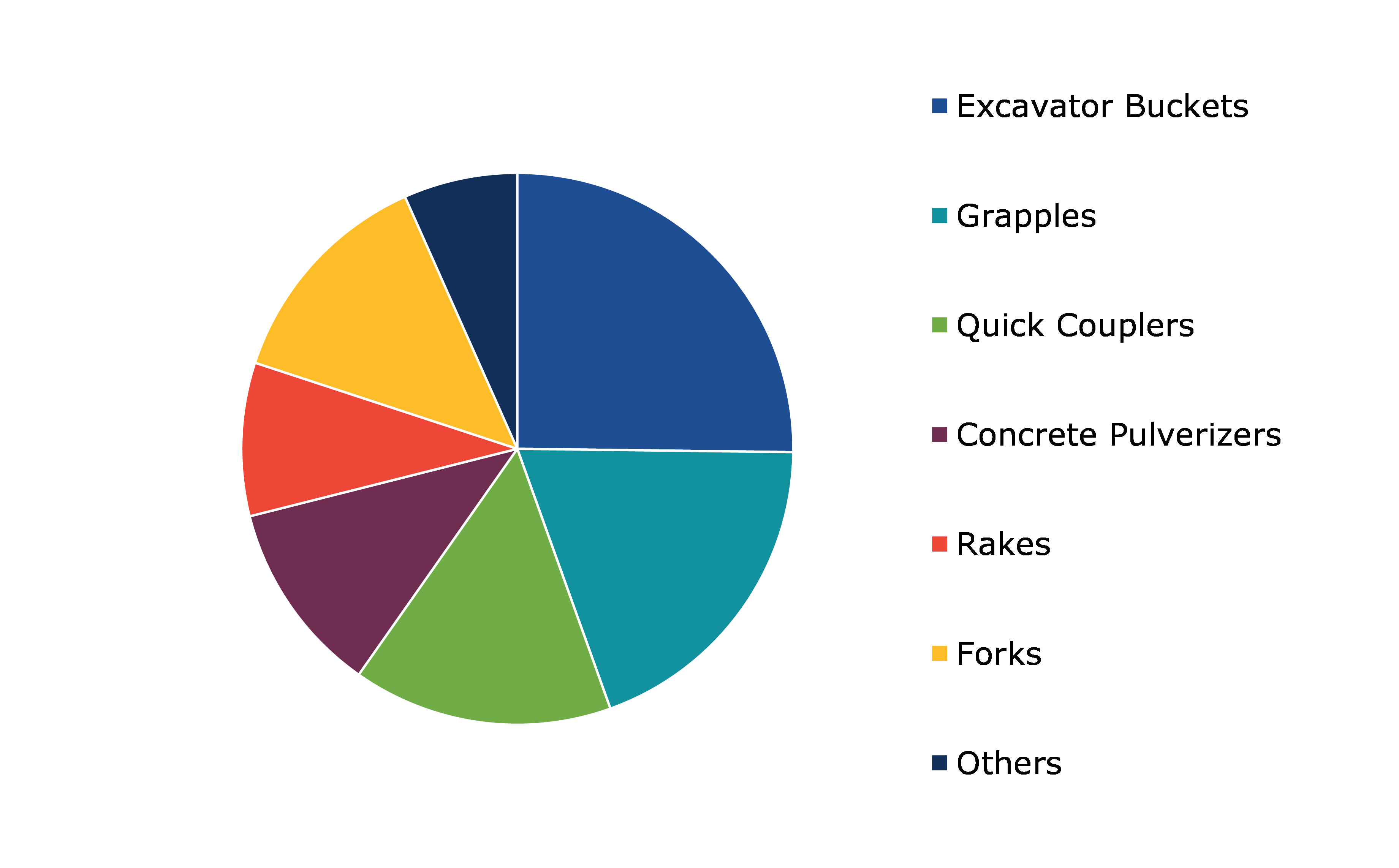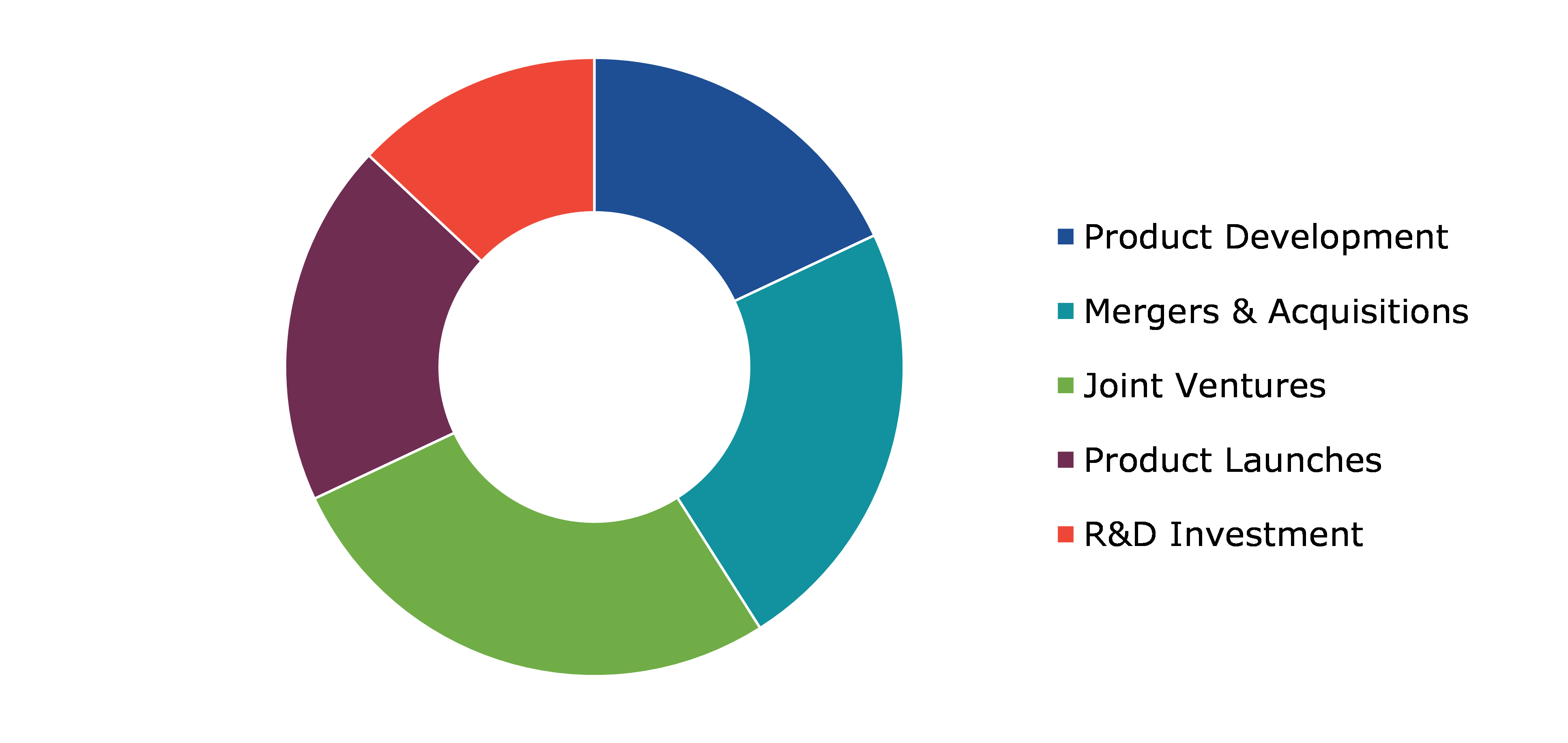Construction Machinery Attachment Market Report
RA08619
Construction Machinery Attachment Market by Attachment Type (Excavator Buckets, Grapples, Quick Couplers, Concrete Pulverizers, Rakes, Forks, and Others), Application (Earthmoving, Landscaping, Roadwork, Demolition, and Miscellaneous), Sales Channel (OEM and Aftermarket), End-use Industry (Construction, Mining, Trenching, Solid Waste Management, and Agricultural Farm's Application), and Regional Analysis (North America, Europe, Asia-Pacific, and LAMEA): Global Opportunity Analysis and Industry Forecast, 2022-2031
Global Construction Machinery Attachment Market Analysis
The Global Construction Machinery Attachment Market Size was $5,890.0 million in 2021 and is predicted to grow with a CAGR of 4.8%, by generating a revenue of $9,448.7 million by 2031.
Global Construction Machinery Attachment Market Synopsis
The global increase in construction, mining, and urbanization is estimated to boost the construction machinery attachment market demand in the coming years. Advantageous government initiatives, including economic stimulus and reduced mortgage rates, are likely to promote market expansion throughout the forecast period. The growing popularity of electric construction machinery attachment is likely to generate new income streams for OEMs in the near future. These machines run on batteries and have several advantages, including lower maintenance, less noise, less vibration, and better ease for laborers to use in the field. Rising global construction spending is one of the long-term factors expected to boost market sales over the forecast period. The U.S. has witnessed significant growth in construction machinery attachment spending over the last few years. These factors are anticipated to boost the construction machinery attachment industry growth in the upcoming years.
However, some of the disadvantages of construction machinery attachment include lack of dedicated infrastructure. Also, the global economy is in disarray, as a result of various economic shifts among the world's key trade partners. The trade war between the United States and China affected all the economies, since they were the primary actors in the global business. The trade war between world's two largest economies has resulted in increased import duties on billions of dollars' worth goods. However, the recent coronavirus outbreak has significantly hampered economic activities globally and as a result, it has reduced the total manufacturing capacity and hence, is expected to harm the worldwide construction machinery attachment demand.
The growing number of smart city initiatives are increasing the demand or construction machinery attachments such as sideshifters, fork positioners, rotators, rotators with separate side shifts, and others. A smart city has utilities such as roads, metro trains, hotels, and hospitals. For instance, the smart cities mission launched by the Government of India in 2015, focuses on promoting the development of cities to offer clean and sustainable environment to the citizens. The latest technological trends in construction machinery attachment industry with the help of digital technology and shift towards sustainability are anticipated to generate excellent opportunities in the coming years.
According to regional analysis, the Asia-Pacific construction machinery attachment market accounted for the highest market share in the year 2021. This is because countries like China and India have been seen changing their socio-economic factors. The growing number of smart city projects is increasing the demand for construction machinery attachment. These regions are developing large airports, shopping malls, energy projects, and a variety of other large construction projects.
Construction Machinery Attachment Overview
Construction machinery attachments are the additional machineries or components that are attached to the construction machinery to boost the overall efficiency of the construction machinery during the construction activities such as earthmoving, material handling, and others. There are various construction machinery attachments available in the market such as earth drill, forklift, dozer blade, job crane, rock breaker, quick coupler, loader bucket, ripper tooth, and others.
COVID-19 Impact on Global Construction Machinery Attachment Market
The COVID-19 pandemic has posed a negative impact on several industries and the construction machinery attachment market size drastically declined. This is majorly owing to postponement or cancellation of various construction projects. This has ultimately lowered the demand for construction machinery attachment due to disruptions in supply chain, as well as economic slowdown across several countries. In addition, the import-export restrictions were laid down on major construction machinery attachment producing countries such as the U.S. and China. Restricted construction activity, labor scarcity, and uncertain demand for construction had a drastic impact on construction machinery market growth during the pandemic.
Additionally, disruptions in the exports of automotive parts from China as well as closure of automotive assembly and manufacturing units had hampered the construction industry market share during the pandemic. Due to the rapid increase in the number of persons infected with the coronavirus, the government was forced to implement shutdowns, resulting in the temporary closure of several companies. Large infrastructure construction projects were halted because of global social distancing norms. As a result, demand for construction machines fell, and enterprises in the market were forced to suspend or restrict output, thereby reducing market revenues. For example, Hitachi Construction Machinery Co., Ltd., a Japanese construction business that manufactures and sells construction and transportation machinery, declared a halt in production at a number of locations that include Russia, the Middle East, Africa, and Asia during COVID19 lockdowns.
Growing Construction Projects in Industrial Sector to Drive the Market Growth
The construction machinery attachment market is being driven by an increase in construction projects such as malls, multiplexes, and hotels. Government’s spending on various projects to improve the country's infrastructure such as the construction of flyovers, airports, highways, and industrial zones will further boost economic activities. Investments in infrastructure, residential and commercial infrastructure, and increased institutional capital expenditures in the U. S. are some of the factors affecting the expansion of construction machinery manufacturers. The United Kingdom and India have intensified their building operations in various sectors. The rising infrastructure development activities will increase the demand for construction machinery attachments during the forecast period.
To know more about global construction machinery attachment market drivers, get in touch with our analysts here.
Growing Popularity of High Cost of Construction Machinery to Restrain the Market Growth
Construction machinery demands large capital expenditures and technological innovations to ease the construction activities. As a result, it is projected that demand would be hampered with regards to this aspect over the forecast period, and end users may prefer to buy the product rather than lease it, which will be more cost-effective for customers which is anticipated to hamper the construction machinery attachment market growth.
Rapid Growth in Construction & Mining Activities Post-Pandemic to Generate Excellent Opportunities
The construction and mining activities post-pandemic have increased rapidly. For instance, in India the construction of stretches of national highways, as well as the approval and completion of numerous projects and fundraising efforts, will result in significant growth for India's road sector in 2022, making it a better year than the one before it. In 2022, the government authorities prioritized work towards successful implementation of various programmes like comprehensive multi-modal national transportation and logistics network, connectivity with remote and challenging terrains, decongestion of crucial locations on the road network, and advancement with the voluntary vehicle scrappage programme.
Additionally, in January 2022, the government gave its approval for the construction of 21 Greenfield airports across the nation. As per the official statement by the government, in the Gautam Buddha Nagar, Uttar Pradesh, the government has planned to construct the nation's biggest airport in the coming years. Also, India's Ministry of Civil Aviation has further planned to construct 21 more airports. It is expected that The Airports Authority of India (AAI) is likely to spend INR 25,000 crores over the next four to five years to build new airports, expand existing airports, and upgrade several current airports. This includes modifying and enlarging current terminals, building brand-new terminals, enlarging or bolstering current runways, technical blocks, aprons, and the control towers of the Airport Navigation Services. These factors are anticipated to drive the construction machinery attachment market share post-pandemic.
To know more about global construction machinery attachment market opportunities, get in touch with our analysts here.
Global Construction Machinery Attachment Market, by Attachment Type
Based on attachment type, the market has been divided into excavator buckets, grapples, quick couplers, concrete pulverizers, rakes, forks, and others. Among these, the excavator buckets sub-segment accounted for the highest market share in 2021 and the segment is estimated to show the fastest growth during the forecast period.
Global Construction Machinery Attachment Market Size, by Attachment Type, 2021
Source: Research Dive Analysis
The excavator buckets sub-type has accounted for a dominant market share in 2021 and the segment is estimated to show the fastest growth during the forecast period. The excavators are widely used to transfer large amounts of debris and soil. The design is like a human jaw that scoops and transports the garbage to a specific area. These heavy machines are made up of a base cabin and a long arm with an excavator bucket attachment on the end. They are powered by a hydraulic system. The operator controls the excavator from the base cabin, which can rotate 360- degrees. The base cabin is supported by a framework with wheels or tracks. Excavators buckets are commonly used on both small and big construction projects. The popularity of excavator buckets is majorly driven by its growing application in ditching, backfilling, and grading/clearing. These factors are anticipated to boost the growth of the excavator buckets sub-segment during the analysis timeframe.
Global Construction Machinery Attachment Market, by Application
Based on application, the market has been divided into earthmoving, landscaping, roadwork, demolition, and miscellaneous. Among these, the earthmoving sub-segment accounted for highest revenue share in 2021.
Global Construction Machinery Attachment Market Share, by Application, 2021
Source: Research Dive Analysis
The earthmoving sub-segment accounted for dominant market share in 2021. The demand for new infrastructure has risen dramatically in recent years. Earth-moving equipment is easily the most recognizable machinery on any construction site, due to its size and significance. It is used in a wide range of applications in the construction sector. They are used for a variety of earthwork tasks such as installing foundations, grading soil, removing dirt and rocks, excavating trenches, and demolition work. Different forms of earth-moving machines are capable of completing all types of duties, and owing to technical improvements in the industry, there are now many types of earth-moving machinery available in the market that are capable of catering to almost every type of construction activity. Earthmoving activities involves the use of placing pipes, filling trenches, lifting materials, excavation works, and others. These factors are anticipated to boost the growth of earthmoving sub-segment during the analysis timeframe.
Global Construction Machinery Attachment Market, by Sales Channel
Based on sales channel, the market has been divided into OEM and aftermarket. Among these, the aftermarket sub-segment accounted for highest revenue share in 2021.
Global Construction Machinery Attachment Market Analysis, by Sales Channel, 2021
Source: Research Dive Analysis
The aftermarket sub-segment has accounted for highest market share in 2021. The aftermarket parts are available for every construction machinery attachments that can be widely used in construction, agricultural sector, and mining. The aftermarket parts offer various benefits such as affordable equipment care. Compared to the factory parts the aftermarket parts are affordable as they reduce the overhead and help you in gaining profitability. Compared to OEM parts, the aftermarket parts offer several advantages as they are produced by large number of international as well as local manufacturers.
Global Construction Machinery Attachment Market, by End-use Industry
Based on end-use industry, the market has been divided into construction, mining, trenching, solid waste management, and agricultural farm's application. Among these, the construction sub-segment accounted for the highest revenue share in 2021.
Global Construction Machinery Attachment Market Growth, by End-use Industry, 2021
Source: Research Dive Analysis
The construction sub-segment is accounted for a dominant market share in 2021. In the construction sector, where business objectives are rigid and time & profit-oriented, modern construction machinery are critical to ensure on-time completion of construction projects. Modern construction machinery is fast and dependable, with high-quality control methods built in as they have progressed over time. Proper use of this machinery benefits the project's economics, quality, safety, speed, and timeliness. It optimizes the use of materials, manpower, finance, and the scarcity of competent and efficient labor, while keeping a direct eye on the quality standards that are utilized. These factors are anticipated to boost the growth of construction sub-segment during the analysis timeframe.
Global Construction Machinery Attachment Market, Regional Insights
The construction machinery attachment market was investigated across North America, Europe, Asia-Pacific, and LAMEA.
Global Construction Machinery Attachment Market Size & Forecast, by region, 2021-2030 (USD Million)
Source: Research Dive Analysis
The Market for Construction Machinery Attachment in Asia-Pacific was the Most Dominant
The Asia-Pacific construction machinery attachment market accounted for the highest market share in 2021. The region contains two major developing nations on the globe i.e., China and India, both of which are currently experiencing changing socioeconomic circumstances. The growing need for the construction of large airports, shopping malls, energy projects, and a variety of other large construction projects. These trends are projected to continue in the area over the forecast period, driving the expansion of the construction machinery attachment market. China being a major player in the Asia-Pacific region, with a booming building industry driven by its growing economy. These factors are anticipated to boost the construction machinery attachment demand in coming years.
Competitive Scenario in the Global Construction Machinery Attachment Market
Investment and agreement are common strategies followed by major market players. For instance, in April 2022, Caterpillar Inc. updated its product range, including mini excavators, skid steers, and other accessories and small construction equipment for its digital makeover. The corporation announced that it aims to improve and expand its computerized attachments and automated control advancements in its product range.
Source: Research Dive Analysis
Some of the leading construction machinery attachment market players are Case Construction Equipment's, Joseph Cyril Bamford, Dheere & Company, Sany Group, Kubota Corporation, Caterpillar Inc., Komatsu Ltd., Hyundai Construction Equipment, Liebherr group, and Volvo construction equipment.
| Aspect | Particulars |
| Historical Market Estimations | 2020 |
| Base Year for Market Estimation | 2021 |
| Forecast Timeline for Market Projection | 2022-2031 |
| Geographical Scope | North America, Europe, Asia-Pacific, LAMEA |
| Segmentation by Attachment Type |
|
| Segmentation by Application |
|
| Segmentation by Sales Channel |
|
| Segmentation by End-use Industry |
|
| Key Companies Profiled |
|
Q1. What is the size of the global construction machinery attachment market?
A. The size of the global construction machinery attachment market was over $5,890.0 million in 2021 and is projected to reach $9,448.7 million by 2031.
Q2. Which are the major companies in the construction machinery attachment market?
A. Case Construction Equipment's, Joseph Cyril Bamford, and Dheere & Company are some of the key players in the global construction machinery attachment market.
Q3. Which region, among others, possesses greater investment opportunities in the near future?
A. The Asia-Pacific region possesses great investment opportunities for investors to witness the most promising growth in the future.
Q4. What will be the growth rate of the Asia-Pacific construction machinery attachment market?
A. Asia-Pacific construction machinery attachment market is anticipated to grow at 5.4% CAGR during the forecast period.
Q5. What are the strategies opted by the leading players in this market?
A. Agreement and investment are the two key strategies opted by the operating companies in this market.
Q6. Which companies are investing more on R&D practices?
A. Kubota Corporation, Hyundai Construction Equipment, and Liebherr group are the companies investing more on R&D activities for developing new products and technologies.
1.Research Methodology
1.1.Desk Research
1.2.Real time insights and validation
1.3.Forecast model
1.4.Assumptions and forecast parameters
1.5.Market size estimation
1.5.1.Top-down approach
1.5.2.Bottom-up approach
2.Report Scope
2.1.Market definition
2.2.Key objectives of the study
2.3.Report overview
2.4.Market segmentation
2.5.Overview of the impact of COVID-19 on Global construction machinery attachment market
3.Executive Summary
4.Market Overview
4.1.Introduction
4.2.Growth impact forces
4.2.1.Drivers
4.2.2.Restraints
4.2.3.Opportunities
4.3.Market value chain analysis
4.3.1.List of raw material suppliers
4.3.2.List of manufacturers
4.3.3.List of distributors
4.4.Innovation & sustainability matrices
4.4.1.Technology matrix
4.4.2.Regulatory matrix
4.5.Porter’s five forces analysis
4.5.1.Bargaining power of suppliers
4.5.2.Bargaining power of consumers
4.5.3.Threat of substitutes
4.5.4.Threat of new entrants
4.5.5.Competitive rivalry intensity
4.6.PESTLE analysis
4.6.1.Political
4.6.2.Economical
4.6.3.Social
4.6.4.Technological
4.6.5.Environmental
4.7.Impact of COVID-19 on construction machinery attachment market
4.7.1.Pre-covid market scenario
4.7.2.Post-covid market scenario
5.Construction Machinery Attachment Market Analysis, by Attachment Type
5.1.Overview
5.2.Excavator Buckets
5.2.1.Definition, key trends, growth factors, and opportunities
5.2.2.Market size analysis, by region
5.2.3.Market share analysis, by country
5.3.Grapples
5.3.1.Definition, key trends, growth factors, and opportunities
5.3.2.Market size analysis, by region
5.3.3.Market share analysis, by country
5.4.Quick Couplers
5.4.1.Definition, key trends, growth factors, and opportunities
5.4.2.Market size analysis, by region
5.4.3.Market share analysis, by country
5.5.Concrete Pulverizes
5.5.1.Definition, key trends, growth factors, and opportunities
5.5.2.Market size analysis, by region
5.5.3.Market share analysis, by country
5.6.Rakes
5.6.1.Definition, key trends, growth factors, and opportunities
5.6.2.Market size analysis, by region
5.6.3.Market share analysis, by country
5.7.Forks
5.7.1.Definition, key trends, growth factors, and opportunities
5.7.2.Market size analysis, by region
5.7.3.Market share analysis, by country
5.8.Others
5.8.1.Definition, key trends, growth factors, and opportunities
5.8.2.Market size analysis, by region
5.8.3.Market share analysis, by country
5.9.Research Dive Exclusive Insights
5.9.1.Market attractiveness
5.9.2.Competition heatmap
6.Construction Machinery Attachment Market Analysis, by Application
6.1.Earthmoving
6.1.1.Definition, key trends, growth factors, and opportunities
6.1.2.Market size analysis, by region
6.1.3.Market share analysis, by country
6.2.Landscaping
6.2.1.Definition, key trends, growth factors, and opportunities
6.2.2.Market size analysis, by region
6.2.3.Market share analysis, by country
6.3.Roadwork
6.3.1.Definition, key trends, growth factors, and opportunities
6.3.2.Market size analysis, by region
6.3.3.Market share analysis, by country
6.4.Demolition
6.4.1.Definition, key trends, growth factors, and opportunities
6.4.2.Market size analysis, by region
6.4.3.Market share analysis, by country
6.5.Miscellaneous
6.5.1.Definition, key trends, growth factors, and opportunities
6.5.2.Market size analysis, by region
6.5.3.Market share analysis, by country
6.6.Research Dive Exclusive Insights
6.6.1.Market attractiveness
6.6.2.Competition heatmap
7.Construction Machinery Attachment Market Analysis, by Sales Channel
7.1.OEM
7.1.1.Definition, key trends, growth factors, and opportunities
7.1.2.Market size analysis, by region
7.1.3.Market share analysis, by country
7.2.Aftermarket
7.2.1.Definition, key trends, growth factors, and opportunities
7.2.2.Market size analysis, by region
7.2.3.Market share analysis, by country
7.3.Research Dive Exclusive Insights
7.3.1.Market attractiveness
7.3.2.Competition heatmap
8.Construction Machinery Attachment Market Analysis, by End-use Industry
8.1.Construction
8.1.1.Definition, key trends, growth factors, and opportunities
8.1.2.Market size analysis, by region
8.1.3.Market share analysis, by country
8.2.Mining
8.2.1.Definition, key trends, growth factors, and opportunities
8.2.2.Market size analysis, by region
8.2.3.Market share analysis, by country
8.3.Trenching
8.3.1.Definition, key trends, growth factors, and opportunities
8.3.2.Market size analysis, by region
8.3.3.Market share analysis, by country
8.4.Solid Waste Management
8.4.1.Definition, key trends, growth factors, and opportunities
8.4.2.Market size analysis, by region
8.4.3.Market share analysis, by country
8.5.Agricultural Farm's Application
8.5.1.Definition, key trends, growth factors, and opportunities
8.5.2.Market size analysis, by region
8.5.3.Market share analysis, by country
8.6.Research Dive Exclusive Insights
8.6.1.Market attractiveness
8.6.2.Competition heatmap
9.Construction Machinery Attachment Market, by region
9.1.North America
9.1.1.U.S.
9.1.1.1.Market size analysis, by Attachment Type
9.1.1.2.Market size analysis, by Application
9.1.1.3.Market size analysis, by Sales Channel
9.1.1.4.Market size analysis, by End-use Industry
9.1.2.Canada
9.1.2.1.Market size analysis, by Attachment Type
9.1.2.2.Market size analysis, by Application
9.1.2.3.Market size analysis, by Sales Channel
9.1.2.4.Market size analysis, by End-use Industry
9.1.3.Mexico
9.1.3.1.Market size analysis, by Attachment Type
9.1.3.2.Market size analysis, by Application
9.1.3.3.Market size analysis, by Sales Channel
9.1.3.4.Market size analysis, by End-use Industry
9.1.4.Research Dive Exclusive Insights
9.1.4.1.Market attractiveness
9.1.4.2.Competition heatmap
9.2.Europe
9.2.1.Germany
9.2.1.1.Market size analysis, by Attachment Type
9.2.1.2.Market size analysis, by Application
9.2.1.3.Market size analysis, by Sales Channel
9.2.1.4.Market size analysis, by End-use Industry
9.2.2.UK
9.2.2.1.Market size analysis, by Attachment Type
9.2.2.2.Market size analysis, by Application
9.2.2.3.Market size analysis, by Sales Channel
9.2.2.4.Market size analysis, by End-use Industry
9.2.3.France
9.2.3.1.Market size analysis, by Attachment Type
9.2.3.2.Market size analysis, by Application
9.2.3.3.Market size analysis, by Sales Channel
9.2.3.4.Market size analysis, by End-use Industry
9.2.4.Spain
9.2.4.1.Market size analysis, by Attachment Type
9.2.4.2.Market size analysis, by Application
9.2.4.3.Market size analysis, by Sales Channel
9.2.4.4.Market size analysis, by End-use Industry
9.2.5.Italy
9.2.5.1.Market size analysis, by Attachment Type
9.2.5.2.Market size analysis, by Application
9.2.5.3.Market size analysis, by Sales Channel
9.2.5.4.Market size analysis, by End-use Industry
9.2.6.Rest of Europe
9.2.6.1.Market size analysis, by Attachment Type
9.2.6.2.Market size analysis, by Application
9.2.6.3.Market size analysis, by Sales Channel
9.2.6.4.Market size analysis, by End-use Industry
9.2.7.Research Dive Exclusive Insights
9.2.7.1.Market attractiveness
9.2.7.2.Competition heatmap
9.3.Asia Pacific
9.3.1.China
9.3.1.1.Market size analysis, by Attachment Type
9.3.1.2.Market size analysis, by Application
9.3.1.3.Market size analysis, by Sales Channel
9.3.1.4.Market size analysis, by End-use Industry
9.3.2.Japan
9.3.2.1.Market size analysis, by Attachment Type
9.3.2.2.Market size analysis, by Application
9.3.2.3.Market size analysis, by Sales Channel
9.3.2.4.Market size analysis, by End-use Industry
9.3.3.India
9.3.3.1.Market size analysis, by Attachment Type
9.3.3.2.Market size analysis, by Application
9.3.3.3.Market size analysis, by Sales Channel
9.3.3.4.Market size analysis, by End-use Industry
9.3.4.Australia
9.3.4.1.Market size analysis, by Feedstock
9.3.4.2.Market size analysis, by End-use Industry
9.3.5.South Korea
9.3.5.1.Market size analysis, by Attachment Type
9.3.5.2.Market size analysis, by Application
9.3.5.3.Market size analysis, by Sales Channel
9.3.5.4.Market size analysis, by End-use Industry
9.3.6.Rest of Asia Pacific
9.3.6.1.Market size analysis, by Attachment Type
9.3.6.2.Market size analysis, by Application
9.3.6.3.Market size analysis, by Sales Channel
9.3.6.4.Market size analysis, by End-use Industry
9.3.7.Research Dive Exclusive Insights
9.3.7.1.Market attractiveness
9.3.7.2.Competition heatmap
9.4.LAMEA
9.4.1.Brazil
9.4.1.1.Market size analysis, by Attachment Type
9.4.1.2.Market size analysis, by Application
9.4.1.3.Market size analysis, by Sales Channel
9.4.1.4.Market size analysis, by End-use Industry
9.4.2.Saudi Arabia
9.4.2.1.Market size analysis, by Attachment Type
9.4.2.2.Market size analysis, by Application
9.4.2.3.Market size analysis, by Sales Channel
9.4.2.4.Market size analysis, by End-use Industry
9.4.3.UAE
9.4.3.1.Market size analysis, by Attachment Type
9.4.3.2.Market size analysis, by Application
9.4.3.3.Market size analysis, by Sales Channel
9.4.3.4.Market size analysis, by End-use Industry
9.4.4.South Africa
9.4.4.1.Market size analysis, by Attachment Type
9.4.4.2.Market size analysis, by Application
9.4.4.3.Market size analysis, by Sales Channel
9.4.4.4.Market size analysis, by End-use Industry
9.4.5.Rest of LAMEA
9.4.5.1.Market size analysis, by Attachment Type
9.4.5.2.Market size analysis, by Application
9.4.5.3.Market size analysis, by Sales Channel
9.4.5.4.Market size analysis, by End-use Industry
9.4.6.Research Dive Exclusive Insights
9.4.6.1.Market attractiveness
9.4.6.2.Competition heatmap
10.Competitive Landscape
10.1.Top winning strategies, 2021
10.1.1.By strategy
10.1.2.By year
10.2.Strategic overview
10.3.Market share analysis, 2021
11.Company Profiles
11.1.Caterpillar Inc.
11.1.1.Overview
11.1.2.Business segments
11.1.3.Product portfolio
11.1.4.Financial performance
11.1.5.Recent developments
11.1.6.SWOT analysis
11.2.Komatsu Ltd.
11.2.1.Overview
11.2.2.Business segments
11.2.3.Product portfolio
11.2.4.Financial performance
11.2.5.Recent developments
11.2.6.SWOT analysis
11.3.John Deere
11.3.1.Overview
11.3.2.Business segments
11.3.3.Product portfolio
11.3.4.Financial performance
11.3.5.Recent developments
11.3.6.SWOT analysis
11.4.JCB
11.4.1.Overview
11.4.2.Business segments
11.4.3.Product portfolio
11.4.4.Financial performance
11.4.5.Recent developments
11.4.6.SWOT analysis
11.5.Doosan Corporation
11.5.1.Overview
11.5.2.Business segments
11.5.3.Product portfolio
11.5.4.Financial performance
11.5.5.Recent developments
11.5.6.SWOT analysis
11.6.Liebherr
11.6.1.Overview
11.6.2.Business segments
11.6.3.Product portfolio
11.6.4.Financial performance
11.6.5.Recent developments
11.6.6.SWOT analysis
11.7.Hyundai Construction Equipment Co., Ltd.
11.7.1.Overview
11.7.2.Business segments
11.7.3.Product portfolio
11.7.4.Financial performance
11.7.5.Recent developments
11.7.6.SWOT analysis
11.8.Volvo Construction Equipment AB
11.8.1.Overview
11.8.2.Business segments
11.8.3.Product portfolio
11.8.4.Financial performance
11.8.5.Recent developments
11.8.6.SWOT analysis
11.9.Sany
11.9.1.Overview
11.9.2.Business segments
11.9.3.Product portfolio
11.9.4.Financial performance
11.9.5.Recent developments
11.9.6.SWOT analysis
11.10.Bobcat Company
11.10.1.Overview
11.10.2.Business segments
11.10.3.Product portfolio
11.10.4.Financial performance
11.10.5.Recent developments
11.10.6.SWOT analysis
12.Appendix
12.1.Parent & peer market analysis
12.2.Premium insights from industry experts
12.3.Related reports
Construction machinery attachments play an essential role in the construction industry. These attachments can be used for a variety of tasks including digging, lifting, grading, and demolition. Construction machinery attachments such as buckets, rippers, and hammers can be added to excavators and backhoes to make them more versatile and capable of handling different tasks. With the right attachment, an operator can complete a task more efficiently and with less physical effort. This not only increases productivity but also reduces the risk of injury. Moreover, the attachments can be used to save money. Instead of purchasing multiple machines for different tasks, a single machine can be equipped with different attachments to perform a range of tasks. This saves money on equipment costs, maintenance costs, and training costs.
Forecast Analysis of the Global Construction Machinery Attachment Market
According to the report published by Research Dive, the global construction machinery attachment market is anticipated to generate a revenue of $9,448.7 million and rise at a CAGR of 4.8% during the analysis timeframe from 2022 to 2031.
The growing construction projects across the industrial sector such as flyovers, airports, highways, malls, multiplexes, hotels, and many more are expected to bolster the growth of the construction machinery attachment market during the analysis timeframe. Moreover, the rapid growth in construction & mining activities post-pandemic and various government initiatives for the implementation of various construction programs and projects such as multi-modal national transportation and logistics network and many more is expected to create wide growth opportunities during the forecast timeframe. However, the growing popularity of the high cost of construction machinery may hinder the growth of the market throughout the estimated period.
The major players of the construction machinery attachment market include Caterpillar Inc., Kubota Corporation, Komatsu Ltd., Sany Group, Hyundai Construction Equipment, Dheere & Company, Liebherr Group, Joseph Cyril Bamford, Volvo construction equipment, Case Construction Equipment, and many more.
Key Developments
The key companies operating in the industry are adopting various growth strategies & business tactics such as partnerships, collaborations, mergers & acquisitions, and launches to maintain a robust position in the overall market, which is subsequently helping the global construction machinery attachment market to grow exponentially. For instance:
- In June 2022, John Deere, a leading provider of 5D series tractors ranging from 36HP to 55 HP announced its collaboration with Wacker Neuson, a renowned manufacturer of compact and construction machines. With this collaboration, John Deere aimed to develop excavators of less than 5 metric tons and 5-9 metric ton excavators that would be designed by Wacker Neuson.
- In November 2022, Epiroc, a renowned productivity and sustainability partner for the mining and infrastructure industries announced its acquisition of Wain-Roy, a U.S.-based leading manufacturer of excavator attachments for the construction industry. This acquisition would strengthen the presence of Wain-Roy in the North American construction market and increase our capacity for manufacturing advanced attachments across the region.
- In March 2023, Tata Hitachi, a leading manufacturer of excavation equipment launched its new product namely, “Mining Excavator ZX670H”. The product is designed to offer high durability, easy maintenance, low operating cost, unmatched efficiency, optimum comfort, and maximum safety.
Most Profitable Region
The Asia-Pacific region of the construction machinery attachment market held the largest market share in 2021. The increasing need for the construction of large shopping malls, large airports, energy projects, and various other large construction projects, and the growing economy across the region are expected to boost the regional growth of the market throughout the estimated timeframe.
Covid-19 Impact on the Construction Machinery Attachment Market
The outbreak of the Covid-19 pandemic has declined the growth of the construction machinery attachment market, likewise various other industries. This is mainly due to the postponement of various construction projects during the pandemic period. Moreover, the disruptions in the supply chain and economic slowdown across various countries have lowered the demand for construction machinery attachments. Furthermore, import-export restrictions, labor scarcity, restricted construction activity, and uncertain demand for construction have further declined the growth of the market throughout the crisis.
Personalize this research
- Triangulate with your own data
- Request your format and definition
- Get a deeper dive on a specific application, geography, customer or competitor
- + 1-888-961-4454 Toll - Free
- support@researchdive.com








